Do you know what one of the biggest fears for lash techs in the beauty industry is when working on clients? It’s allergies. I’m not trying to scare you, but allergies that seem impossible to happen can unexpectedly jeopardize many lives. So why am I mentioning this in an article about patch tests for eyelash extensions? Keep reading my article today to find out what an eyelash extension patch test is, why lash techs need to know and perform it, how long the testing process takes, and what happens after the eyelash extension patch test! Let’s get started.
Definition of a patch test for eyelash extensions
A patch test for lash extensions is a method to check for any reactions on the client’s body before proceeding with an actual beauty procedure. Performing a patch test is quite simple. You only need to apply a small amount of the product you want to test directly to a patch of skin on the body and wait to see if any adverse reactions occur. For eyelash extensions, typically, lash techs will apply a small amount of adhesive to the natural lash line at the outer corner of your eye. After waiting for a specified period and observing no unexpected reactions, they will proceed with the lash extension application.
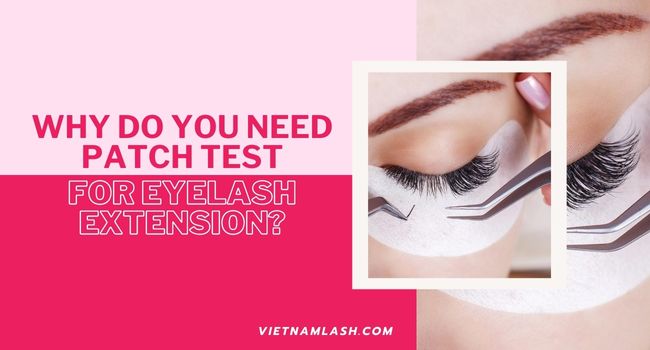
Why do you need patch test for eyelash extensions?
Because the eyes are an extremely important and sensitive part of the body, any impact on the eyes and eyelashes requires the utmost caution. Eyelash extension application, which involves the use of adhesive, can potentially trigger reactions in both normal and allergic individuals. Therefore, conducting a patch test for eyelash extensions about 20-24 hours prior to the actual lash application is a method to ensure the safety of the client.
As a lash tech, you must ensure that your client is compatible with the type of adhesive you plan to use. Clients need not worry that the patch test will take up too much time; it’s a one-time procedure done before their first lash extension appointment. Of course, this assumes that the client is a familiar face to the lash tech. Once the lash tech is familiar with the client and knows which adhesive suits them, there’s no need to repeat the patch test for every subsequent lash extension appointment.
>> Learn how to choose the right lash adhesive for sensitive eyes in our expert guide. Prioritize safety and beauty seamlessly with our recommendations: The perfect eyelash glue for sensitive eyes
The way to do a patch test for eyelash extensions
There are various ways to conduct an eyelash extension patch test, but most of them involve several common steps. I’ll summarize these common points for everyone’s reference.
Firstly, the client and lash tech should schedule an appointment for the patch test. This test should ideally be performed about 24 hours before the lash extension appointment. This time frame allows for the slowest possible negative reactions to become evident.
The way to do a patch test for eyelash extensions. The lash tech will typically apply a minimal amount of adhesive to 10-12 eyelashes on the outer corner of the client’s eye.
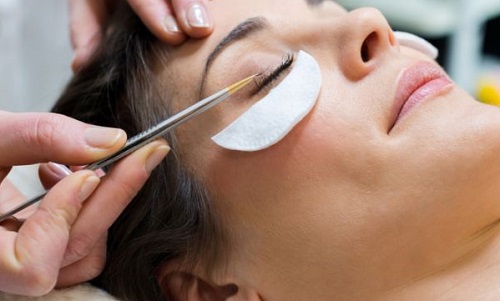
On the scheduled day, the lash tech will perform the reaction check for the client. There are several methods for lash techs to do this, but the most widely used and precise method is to apply a small amount of adhesive directly to the eyelashes. They will typically apply a minimal amount of adhesive to 10-12 eyelashes on the outer corner of the client’s eye. This mimics the process of the adhesive coming into contact with the eyelashes during the lash extension application. Placing the test adhesive on the outer lashes makes it easier to handle if any adverse reactions occur.
Some lash techs may opt to conduct the test by applying a small amount of adhesive to a sensitive and thin-skinned area, like the skin behind the client’s ear. However, personally, I believe this method is not entirely reliable. The skin around the eyes is the most sensitive, and testing on other areas may not accurately reflect the product’s safety for the eye area.
Eyelash Extension Patch Test Reaction and how to treat it?
There are two types of reactions that can occur during an eyelash extension patch test: allergies and irritations. This is because the skin around the client’s eyes can be overly sensitive to the components in eyelash extension adhesive, such as cyanoacrylate. Alternatively, irritations can be caused by the fumes emitted by the adhesive when it comes into contact with humidity in the air. Irritations often manifest as redness and watery eyes and typically appear shortly after the test.
Patch test for eyelash extensions are important. Eyes are very vulnerable, lash tech should be careful with any action on it
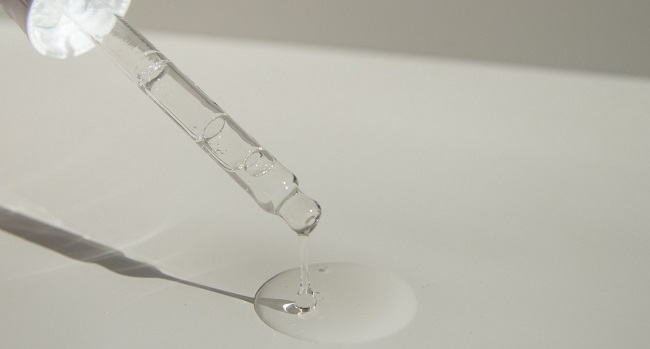
If, unfortunately, a client experiences symptoms like itching or redness, lash techs can guide them to try a 0.1% NaCl (sodium chloride) eye rinse solution and monitor the results over a few hours. If the symptoms do not improve, it’s advisable to invite them to the salon to use a specialized adhesive remover because this may be allergies.
Allergies are more severe. Allergies often lead to swelling, redness, peeling, and even pain around the eye area. In such cases, lash techs should immediately remove the eyelash extensions and clean the eye area. Clients may need to seek medical attention if necessary. Lash tech may consider trying a different adhesive for the client. Use a sensitive adhesive for individuals with sensitive skin!
Allergies can be a devastating experience for clients, as they may indicate that they can never have lash extensions again. Therefore, conducting a patch test before the actual lash application is essential to ensure safety!”
>> Handle customer allergies with care! Proper reaction management is crucial. Explore our expert guide for handling allergies effectively: Lash Glue Allergy: Causes And Treatments
FAQ
That’s the information about patch tests for eyelash extensions I wanted to share. In the next part, I will answer some of the most frequently asked questions I’ve received from you, my readers, on this topic!
01: Do lash tech need to have an eyelash extension patch test form?
Many of you have asked me if a patch test form is necessary. My answer is yes! This is because allergic reactions are related to the client’s health. Everyone’s body reacts differently, so allergic reactions can vary in severity. Some allergies can be life-threatening. Lash techs cannot predict how their clients will react to allergies. Lash techs can only inform clients about potential risks. Clients need to sign a waiver to protect the lash tech’s rights in case unfortunate events occur.
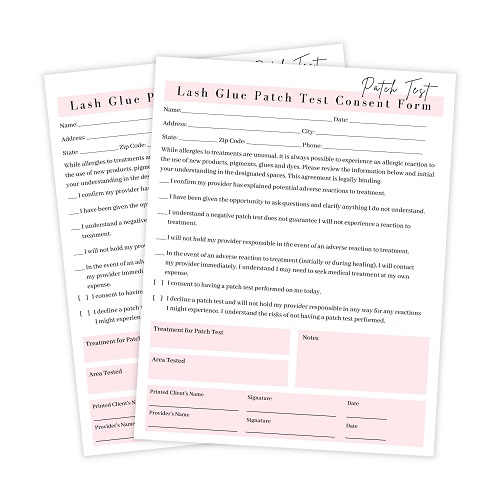
02: I don’t have much time, can a patch test for eyelash extensions be done in 1 hour, then can I apply eyelash extensions?
For this question, my answer is quite the opposite. No! You should not cut short any step in the eyelash extension process, especially the patch test. It is related to the client’s health. If you don’t want to lose credibility with your clients, absolutely do not do this. Some allergies can occur immediately, but there are also cases where it takes 12 hours or even 24 hours for an allergic reaction to develop. So, don’t rush through this step!
Conclusion:
Okay! My blog today is relatively short, but I’ve conveyed all the essential information about patch tests for eyelash extensions to you. I hope the information I provided about the concept, the steps, and the considerations after performing an eyelash extension patch test is helpful to you. If you find this blog useful, please like and follow more of Vietnam Lash’s blogs to stay updated on the latest information in the eyelash extension industry! Goodbye, and I’ll see you in the next blog.
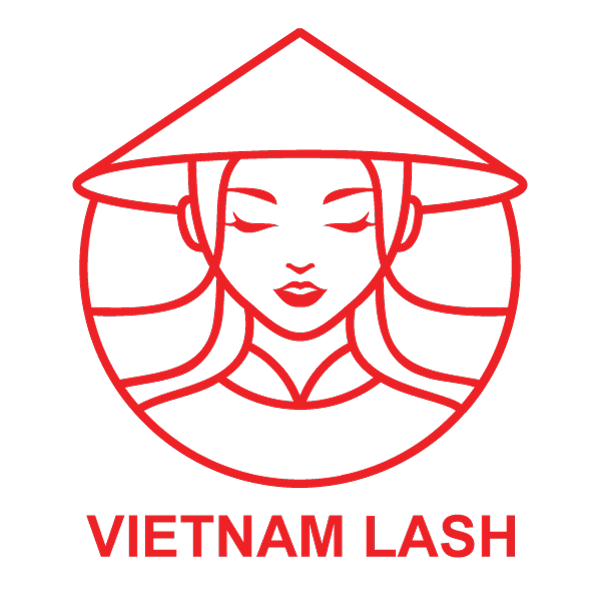
 +84 862 765 053
+84 862 765 053